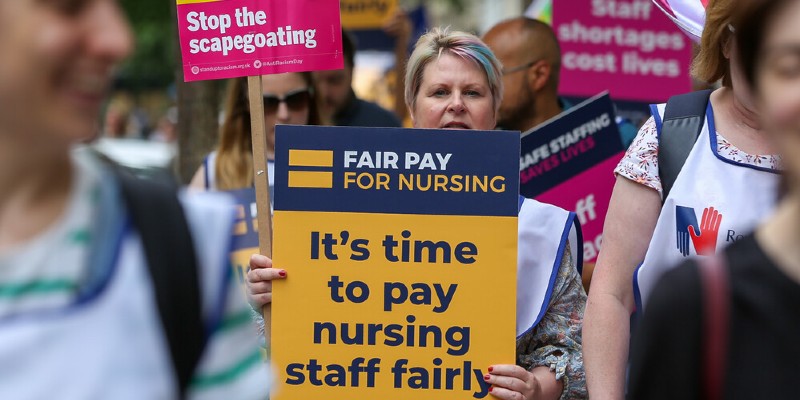Nearly 2.5 million working days were lost to industrial action between June and December, the highest since 1989…reports Asian Lite News
Britain lost more working days to strikes in 2022 than in any year since 1989, as employees walked out in large numbers over pay amid soaring living costs.
Figures from the Office for National Statistics (ONS) showed that nearly 2.5 million working days were lost to industrial action between June and December, the highest since 1989 when 4.1 million days were lost.
The ONS said 843,000 working days were lost in December 2022 alone — the highest monthly number since November 2011.
Workers in health care, communications and transportation were among those who walked out in the run-up to Christmas. The Royal College of Nursing, which represents nearly 500,000 nurses, midwives and health care assistants, staged its first ever strike in December.
Britain hit by biggest day of strikes in a decade as pay disputes escalate
Strike action has dragged into the new year, disrupting schools and public transport. As many as half a million workers, including teachers, staged the biggest single day of walkouts in more than a decade on February 1.
Workers are demanding higher wages as they grapple with a cost-of-living crisis, with inflation near its highest level in four decades. Many public sector workers have been offered raises of 4% or 5% for the current financial year, far lower than the 10.5% annual inflation rate in December. The ONS will publish inflation figures for January on Wednesday.
The government has so far refused to grant public sector workers higher pay awards, arguing that doing so risks making the inflation problem worse. The government is instead introducing laws that will make it harder for key workers to strike.
The ONS said Tuesday that after taking inflation into account, growth in average regular pay, which excludes bonuses, fell by 2.5% between October and December 2022 compared with the same period in 2021. That’s among the largest drops since records began in 2001.
For public sector workers, the decline in real pay will have been worse as, without adjusting for inflation, their wages grew a lot less compared with private sector earnings. Average regular pay growth for the public sector was 4.2% in the final three months of last year compared with the same period in 2021, versus growth of 7.3% for the private sector.
The ONS said private sector pay growth was at its strongest outside the height of the coronavirus pandemic.
“Although there is still a large gap between earnings growth in the public and private sectors, this narrowed slightly in the latest period,” ONS director of economic statistics Darren Morgan said in a statement. “Overall, pay, though, continues to be outstripped by rising prices.”
A separate survey published Monday by the Chartered Institute of Personnel Development (CIPD) found that UK employers expect to give employees a median pay rise of 5% this year, the highest increase in 11 years.
“However, median anticipated public sector pay rise expectations of 2% lag those in the private sector at 5%, with the gap providing the context for ongoing discontent and strikes among key public sector workers,” the CIPD said.
Sunak explores public sector pay deal
Meanwhile, Prime Minister Rishi Sunak and finance minister Jeremy Hunt are considering a deal to end a wave of strikes among Britain’s public sector workers that would backdate next year’s pay rise.
Sunak and Hunt are mulling giving NHS staff and other key workers a lump-sum payment by backdating next year’s pay award, which takes effect from April, likely to the start of January 2023.
The Department of Health and Social Care (DHSC) said that Health Minister Steve Barclay has held talks with healthcare unions about what is affordable and fair for the 2023-24 pay review body process, including wider concerns about pay, conditions and workload.
“We want to strike the right balance between what is fair for public sector workers and what the taxpayer – ordinary people across the UK – can afford,” DHSC said in a statement.
A public sector pay rise of less than 5% for 2023-24 would have a “low risk” of protracting high private sector pay growth, 6% would worsen inflation, and 7% would “pose a significant risk” and could bring about higher interest rates.
With inflation running at more than 10% – the highest level in four decades – Britain has seen a wave of strikes in recent months across the public and private sectors, including health and transport workers, Amazon warehouse employees and Royal Mail postal staff.
The strikers are demanding above-inflation pay rises to cover rocketing food and energy bills that they say have left them struggling to make ends meet.

Leave a Reply